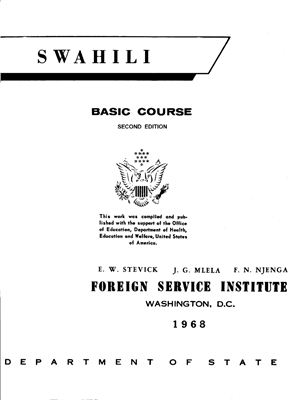Разработчик: Foreign Service Institute
Год выпуска: 1968
Количество страниц: 587
Общее время звучания: 13 ч 45 мин
Формат: PDF+MP3
Качество аудио: 32 кбит/сек, 22 КГц, моно
Язык: английский
Swahili Basic Course aims first of all at assisting the student to develop ability in understanding and speaking everyday Swahili of a standard variety. On the basis of well-established speech habits, he can then go on with relatively high efficiency to the further skills of reading and writing. The course is designed for use in any of three general types of study situation: (1) a full-time language program of thirty or more hours per week, (2) a language program in which one or more part-time students attend class for three to six hours per week, and (3) (much the least desirable) individual study in the absence of any speaker of the language. In any of these situations, the class should be guided in such a way that it concentrates on one small task at a time. For this reason, the 150 units of the course are comparatively short. Each unit is in tu divided into a brief dialogue (with notes) and a series of short exercises. The dialogues and exercises are further broken up into individual lines. In most of the exercises, there is a further division into two or three columns. The word or phrase at the left is called the 'cue.' The sentence in the next column is the 'desired response' to that cue. In those exercises having a third column in Swahili, the sentence in the second column is intended to serve as a secondary cue, and the corresponding sentence in the third column is the desired response to it.
Год выпуска: 1968
Количество страниц: 587
Общее время звучания: 13 ч 45 мин
Формат: PDF+MP3
Качество аудио: 32 кбит/сек, 22 КГц, моно
Язык: английский
Swahili Basic Course aims first of all at assisting the student to develop ability in understanding and speaking everyday Swahili of a standard variety. On the basis of well-established speech habits, he can then go on with relatively high efficiency to the further skills of reading and writing. The course is designed for use in any of three general types of study situation: (1) a full-time language program of thirty or more hours per week, (2) a language program in which one or more part-time students attend class for three to six hours per week, and (3) (much the least desirable) individual study in the absence of any speaker of the language. In any of these situations, the class should be guided in such a way that it concentrates on one small task at a time. For this reason, the 150 units of the course are comparatively short. Each unit is in tu divided into a brief dialogue (with notes) and a series of short exercises. The dialogues and exercises are further broken up into individual lines. In most of the exercises, there is a further division into two or three columns. The word or phrase at the left is called the 'cue.' The sentence in the next column is the 'desired response' to that cue. In those exercises having a third column in Swahili, the sentence in the second column is intended to serve as a secondary cue, and the corresponding sentence in the third column is the desired response to it.

